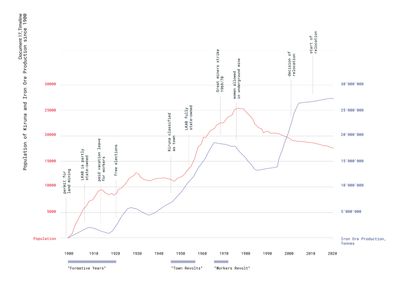The Mine, Not the City
Fiona Wiesner
This video essay examines the precarious spatial proximity between the city of Kiruna and the adjacent iron ore mine—a relationship that strongly defines the town’s location, social identity, and future. The footage was filmed and edited during autumn and winter 2023. A newspaper headline first drew my attention to Kiruna: this town in the far north of Sweden is being relocated due to underground iron ore mining. The risk of subsidence, deformations and cracks in the ground is forcing inhabitants to relocate further away from the mine.
Kiruna, where underground extraction began around 1900, is an extreme case of dependency. It is built next to one of the largest and most modern iron ore mines in the world, operated by the state-owned company LKAB. By law, LKAB is responsible for financing the town’s relocation. Two-thirds of the population of Kiruna depend upon the mine for employment. Since the beginning of mining operations, LKAB has held considerable political and psychological power over the inhabitants. This asymmetrical power relation is reflected in a local saying: “When the company has a cold, society sneezes.” (1)
Kiruna can be described as a company town, where “virtually everything associated with the settlement, including the houses, store, school and even the chapel, was subordinate to the business enterprise”. (2) Unsurprisingly, there has been only one dominant narrative about the town’s future: the mining activities must continue.
In search of alternative narratives, I traveled to Kiruna in autumn 2023. There, I encountered an almost empty town center and spoke with two protagonists. Kjell Törmä, a documentary photographer who has lived in Kiruna his entire life. He expressed sadness about demolition of the old city center, but also conveyed hope for the new center and a general sense of acceptance. He pointed out issues related to LKAB’s uncontested power position, such as the lack of employment outside the mining industry. He also emphasized that, financially, LKAB has always been much more powerful than the town itself. Anda Crisan, a project strategist from the city administration, moved to Kiruna a few years ago with her family. She spoke about her trust in the urban development, but also highlighted challenges such as the uncertainty regarding her living situation, a shortage of housing, and gaps in social services. Nevertheless, she considers Kiruna a good place to live.
The video work is complemented by an archive that documents the research for the video-essay The mine, not the city. It contains maps, articles, timelines, interviews and stills from on-site video recordings that illustrate the impactful spatial and social proximity of the iron ore mine and the city of Kiruna.
(1) Sandström, Johan et al. “Corporate Paternalism on the Rocks: A Historical Analysis of Power Relations in a Mining Town.” In Management & Organizational History 16, N0. 3–4, 2021. Page 188. https://doi.org/10.1080/17449359.2021.1977142.
(2) Garner, John. The Company Town: Architecture and Society in the Early Industrial Age. Oxford: Oxford University Press, 1994. Page 4.

Map of Kiruna Municipality showing the mine, thea area in danger of subsidence and the projected new town. Source: Lantmateriet and LKAB, Tidsplan för sälj och flytt.

This graphic on the population of Kiruna and Iron Ore Production indicates parallel growth and decline since the 1960s. Since the 2000s, technological advancements have increased production, while changes in the town’s social structure contributed to a population decrease. Source: Sandström, Johan et al. “Corporate Paternalism on the Rocks: A Historical Analysis of Power Relations in a Mining Town.” Management & Organizational History 16, Nr. 3–4 (2021), page 188, Table 1.




